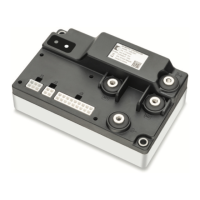3 — PROGRAMMABLE PARAMETERS
pg. 31
Return to TOC Curtis Model 1226 – September 2019
Understanding Low and High Speed Acceleration Rates
You can optimize a vehicle’s throttle response by conguring acceleration rates for low and high
speeds. ese rates are dened with the Full Accel Rate LS and Full Accel Rate HS parameters. You
can congure dierent acceleration rates for each speed mode.
e deceleration rates are relative to the values of the HS(High Speed) and LS(Low Speed) parameters.
See Fine Tuning Menu on page 30.
When full throttle is applied while the vehicle is traveling between the specied low and high speeds,
the acceleration rate is linearly scaled between the low and high acceleration rates.
Note: ese acceleration rates apply to both forward and reverse.
Example
Suppose you set the following parameters to the following values:
PARAMETER VALUES
LS(Low Speed) 30%
HS(High Speed) 70%
Full Accel Rate LS 1.5s
Full Accel Rate HS 3.0s
Figure 10 shows the acceleration rate when full throttle is applied.
ACCEL RATE
(seconds)
M OTOR Voltage
LOW SPEED
(LS
*
Speed Scaler)
= 30%
*
27V = 8.1V
FASTER
Full Accel Rate LS = 1.5
Full Accel Rate HS = 3.0
Low Accel Rate = 8.0s
HIGH SPEED
(HS
*
Speed Scaler)
= 70%
*
27V= 18.9V
Speed Scaler
FASTER
90% Throttle
10% Throttle
INCREASING THROTTLE
Figure 10
Low Speed and High Speed Acceleration Rates
For steps on conguring acceleration rates, see Set the Acceleration and Deceleration Rates on
page 66.

